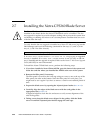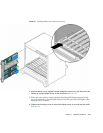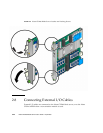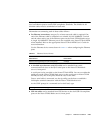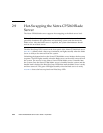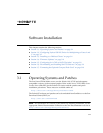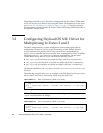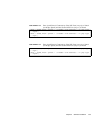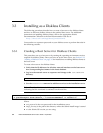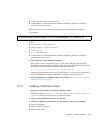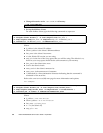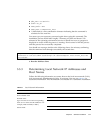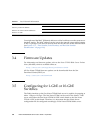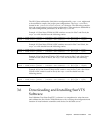
3-2 Netra CP3260 Blade Server User’s Guide • April 2009
Depending the blade server’s hardware configuration, the Sun Netra CP3260 blade
server can be used as a diskless client with the Solaris OS installed on a boot server
(see Section 3.3, “Installing as a Diskless Clients” on page 3-4. The OS can also be
downloaded to a boot device like the Netra CP32x0 SAS Storage ARTM, Dual HD, or
an optional Compact Flash.
3.2 Configuring Payload OS NIU Driver for
Multiplexing to Zones 2 and 3
The MUX configuration by system management software and payload driver
configuration must be in sync for proper functioning of both 10Gbps Ethernet
(nxge) interfaces. The payload driver relies on the driver configuration file
(nxge.conf) to initialize interfaces to either Zone 2 (backplane) or Zone 3 (ARTM).
The driver uses phy-type property to configure each interface. On the Netra
CP3260 blade server, the phy-type can have the following values:
■ phy-type=gsd (for interface to operate at 1Gbps with Zone 2 connectivity)
■ phy-type=xgsd (for interface to operate at 10Gbps with Zone 2 connectivity)
■ phy-type=xgf (for interface to operate at 10Gbps with Zone 3 connectivity)
For default installations, the nxge driver is in the /platform/sun4v/kernel/drv
directory.
The following examples show how to configure zone/link speed in the nxge driver
file for Zone 2 and Zone 3 connectivity when using the Solaris OS.
Note – The phy-type=”gsd” sets the interface at 1Gbps and the phy-type=
”xgsd” sets the interface at 10Gbps.
CODE EXAMPLE 3-1 Zone 2 Connectivity (Both nxge Ports)
name = "SUNW,niusl" parent = "/niu@80" unit-address = "0" phy-type
= "gsd";
name = "SUNW,niusl" parent = "/niu@80" unit-address = "1" phy-type
= "xgsd";
CODE EXAMPLE 3-2 Zone 3 Connectivity (Both nxge Ports)
name = "SUNW,niusl" parent = "/niu@80" unit-address = "0" phy-type
= "xgf";
name = "SUNW,niusl" parent = "/niu@80" unit-address = "1" phy-type
= "xgf";



